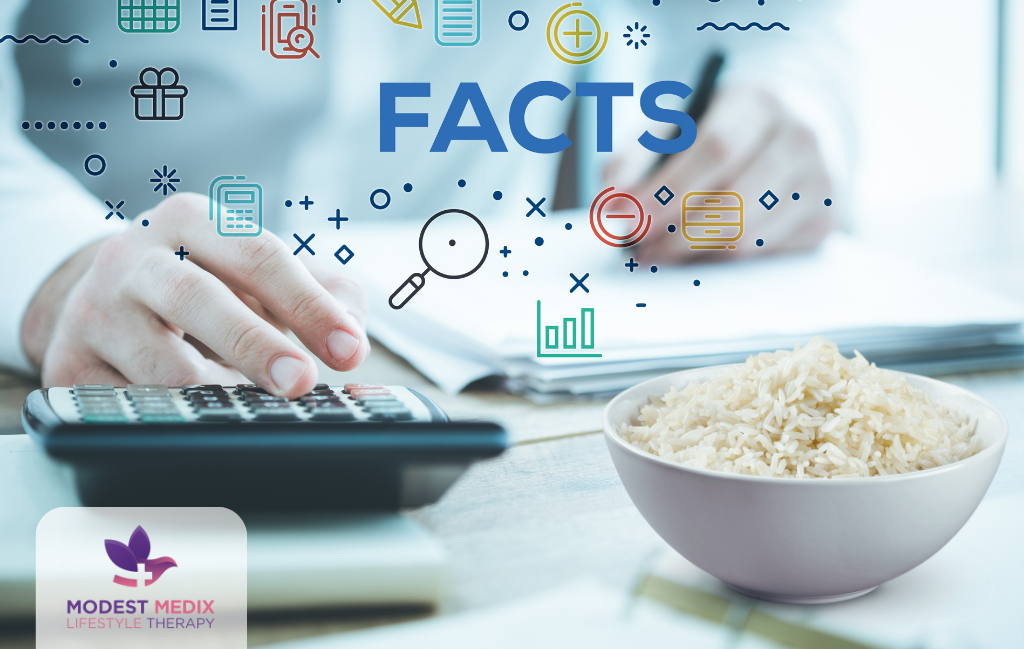In this guide, we’ll explore the calorie impact of rice calories on weight loss with different rice varieties, debunk common myths, and provide practical strategies to help you make informed dietary choices. Our goal is to make your life enjoyable rather than restrictive, giving you the awareness to manage rice intake effectively. We aim to enhance your overall wellness experience, so you won’t feel like a prisoner constantly looking for cheat days.
Dispelling Myths About Rice Calories
A staple in many diets, rice is often misunderstood in weight loss discussions due to misconceptions about its caloric content and Glycemic Index (GI). It is important to recognize that not all rice varieties are created equal. Understanding the subtle variation in calorie counts among different types of rice is crucial for effective weight management. By learning about these differences, you can make an informed decision that supports your weight loss goals and overall wellness… Studying the finer points of rice varieties allows you to navigate your dietary landscape with precision, contributing to sustainable progress toward your wellness aspirations
What is the Glycemic Index (GI)?
The Glycemic Index (GI) is like a report card for carbohydrates, ranking them on a scale from 0 to 100 based on how much they raise blood sugar levels after eating. High GI foods are like the hyper kids in class, quickly digested and causing a rapid spike in blood sugar. On the other hand, low GI foods are the calm, collected students, digested slowly, leading to a gradual rise in blood sugar. Managing GI is especially important for controlling diabetes and weight, as stable blood sugar levels help control appetite and prevent overeating.
Not All Rice is Bad:
Rice often gets a bad rap for its high GI and refining processes, which can raise health concerns. However, not all rice is created equal. In fact, incorporating certain types like parboiled (converted) rice into your diet can be beneficial
White Rice Facts
White rice has often been criticized due to its high GI and refining processes, which raise health concerns. However, not all rice is bad. Incorporating certain types like parboiled and converted rice into your diet can be beneficial.
Green Means Go: Lower GI – Parboiled Rice
Parboiled rice, also known as converted rice, is a great option for managing blood sugar. It’s in the “green” zone according to Diabetes Canada Glycemic Index, meaning you can enjoy it without guilt. Parboiled rice has fewer calories than regular white rice and is packed with extra nutrients due to the parboiling process. It has a better texture, being less sticky and more refined.
Yellow Means Moderation: Medium GI Index
According to Diabetes Canada, rice varieties such as basmati rice, brown rice, and wild rice fall into the medium glycemic index range. These types of rice are digested more slowly than high GI foods, leading to a more gradual increase in blood sugar levels. Choosing these rice varieties can help manage blood sugar levels more effectively while still allowing you to enjoy the flavors and textures of rice in your meals.
- Basmati Rice:
Known for its fragrant aroma and long grains, basmati rice has a medium GI and raises blood sugar levels more gradually than other types of white rice.
- Brown Rice:
This whole grain rice with the bran and germ intact is more nutritious than white rice and has a medium GI, providing a slower and more steady release of sugar into the bloodstream.
- Wild Rice:
Technically a seed from a type of grass, wild rice has a lower GI compared to regular white rice and is rich in protein, fiber, and various nutrients.
Red Means Less Often: High GI Index
According to Diabetes Canada, certain rice varieties fall into the high glycemic index range, meaning they should be chosen less often. These include:
- Jasmine Rice:
Jasmine rice is a fragrant rice with a high GI, which can cause rapid spikes in blood sugar levels. While it’s popular in many cuisines, it should be consumed in moderation, especially for those managing diabetes or aiming for weight loss.
- Sticky Rice:
Also known as glutinous rice, sticky rice has a high GI and is digested quickly, leading to rapid increases in blood sugar levels. It is best to limit its consumption and opt for lower GI alternatives when possible.
- White Rice (Instant):
Instant white rice is pre-cooked and then dehydrated, resulting in a high GI. It’s convenient but should be consumed sparingly due to its potential impact on blood sugar levels.
How Much Rice Should I Eat at One Time?
Portion size plays a crucial role in managing the impact of rice on blood sugar levels. Diabetes Canada recommends keeping portion sizes of grains, including rice, to about 1/2 cup (125 mL) cooked per meal.
Serving Size and What It Means
A serving size of 1/2 cup (125 mL) cooked rice is roughly equivalent to the size of a cupped hand. This visual cue helps manage calorie intake and maintain stable blood sugar levels. By sticking to this serving size, you can enjoy rice as part of a balanced diet without compromising your weight management and blood sugar control efforts. Using your cupped hand as a guide makes it easier to gauge the right portion, ensuring you do not overeat and can effectively manage your diet.
In summary, not all rice is created equal. Understanding the glycemic index and nutritional differences among rice types allows you to make informed choices that support your health and wellness goals. Parboiled rice, basmati rice, brown rice, and wild rice are excellent options for those looking to manage their blood sugar levels and overall health.
Tips for Managing Rice Calories and Aiding Weight Loss
Understand the Glycemic Index:
Knowing the glycemic index of different rice varieties can help you make better choices for managing blood sugar levels. Opt for lower GI options like parboiled rice to support your weight loss and health goals.
Debunk Myths: While brown rice is often considered the best option, parboiled rice is actually more nutritious. It retains more vitamins and minerals and has a lower glycemic index, making it a superior choice for health and weight management.
Consider Resistant Starch:
For added digestive benefits, try cooking rice, cooling it, and then reheating it to increase its resistant starch content.
Practice Mindful Eating:
Engage in mindful eating to recognize and respond to your body’s hunger and fullness cues. Build a good relationship with rice by appreciating it as a part of your diet, eating slowly, and savoring each bite. This can help prevent overeating and promote a sense of gratitude for your meals.
Control Portions:
Managing portion sizes is crucial for controlling the impact of rice on blood sugar levels. Keep portion sizes of cooked rice to about 1/2 cup (125 mL) per meal, roughly equivalent to the size of a cupped hand. This helps manage calorie intake and maintain stable blood sugar levels.
Plan Balanced Meals:
Create well-rounded and nutritionally dense meals. Pair rice with lean proteins like chicken or fish and plenty of vegetables to provide essential vitamins and keep you full and satisfied.
Use Healthy Cooking Methods
Explore different cooking methods to prepare healthier rice dishes. Steaming, boiling, or stir-frying with minimal oil preserves natural flavor and texture while cutting calories.
By implementing these tips, you can effectively manage rice calorie intake and meet weight loss objectives while still enjoying this essential food source.
The Role of Modest Medix in Your Diet Management:
If you’re trying to lose weight and think you have to say no to rice, we’re here for you. At Modest Medix, we understand that rice is a staple in your diet, and asking you to stop eating it would be a struggle. Our registered dietitians (RD)will never ask you to stop eating rice. Instead, we provide personalized diet plans that incorporate rice in a healthy and balanced way. We debunk myths, promote a healthy relationship with food, and ensure you feel empowered, unrestricted, and free from overwhelm.
Understanding the interrelationships between rice calories and diet choices is crucial for weight management and holistic wellness. This knowledge will enable you to make wiser decisions that reflect your wellness goals. ModesT Medix’s unwavering support and expert guidance help you navigate this complex landscape confidently, overcoming challenges and cultivating a lifestyle grounded in health and vitality. Our registered dietitians are dedicated to providing the awareness and support you need to build a positive relationship with food, ensuring you feel powerful and in control of your health journey.
FAQs and Myths About Rice and Weight Loss
Are All Types of Rice Bad?
No, not all types of rice are bad. While some varieties of rice, like white rice, have a high Glycemic Index (GI) and can cause rapid spikes in blood sugar levels, other types like parboiled rice, brown rice, and wild rice have a medium to low GI and offer more nutritional benefits. These types of rice are digested more slowly, leading to a gradual rise in blood sugar, and are rich in vitamins, minerals, and fiber. By choosing these healthier varieties and practicing portion control, rice can be a valuable and nutritious part of a balanced diet.
Is Brown Rice the Best Option for a Healthy Diet?
While it’s true that brown rice is a better choice than white rice due to its higher fiber content and lower glycemic index, parboiled (converted) rice is actually the best option. Parboiled rice has undergone a process that makes it more nutritious than both white and brown rice. It retains more vitamins and minerals, has a lower glycemic index than white rice, and its texture is less sticky, making it a healthier and more versatile choice for managing blood sugar levels and overall health.
Is Wild Rice Better than Brown Rice
Both wild rice and brown rice are excellent choices for weight management and overall health. They both have a medium Glycemic Index (GI), which means they are digested more slowly and cause a gradual rise in blood sugar levels. Wild rice’s distinct flavor and nutritional density, along with brown rice’s high fiber content, make them valuable additions to a balanced diet. Including either in your meal plans can diversify your nutritional intake, promote satiety, aid digestion, and support long-term weight management goals.
How Can I Make Informed Choices Regarding Rice Consumption for Weight Loss?
When making informed decisions about your rice intake, consider caloric content, nutritional value, and personal dietary preferences. Consulting a registered dietitian can provide tailored advice to meet your weight loss goals. Understanding the effects of different rice varieties on weight management will help you make confident and successful dietary choices.
I’m Diabetic, Can I Have Rice?
Yes, you can have rice if you have diabetes, but it’s important to choose the right types and manage your portion sizes. Opt for rice varieties with a lower Glycemic Index (GI), such as parboiled rice, brown rice, and wild rice, as they cause a slower rise in blood sugar levels. Additionally, controlling your portion size to about 1/2 cup (125 mL) cooked rice per meal can help manage blood sugar levels effectively. Always consult with a nutrition expert or dietitian for personalized advice that fits your specific health needs and dietary preferences.
Does All Rice Have the Same Calories?
No, not all rice varieties have the same calorie content. The calorie content can vary based on the type of rice and how it is processed. For example:
Will eating rice cause me to gain weight?
Answer: Eating rice in moderation and as part of a balanced diet does not cause weight gain. Weight gain is typically the result of consuming more calories than you burn. By choosing lower GI varieties and controlling portion sizes, you can include rice in your diet without gaining weight.
Can I eat rice on a low-carb diet?
Answer: While traditional rice is higher in carbohydrates, there are low-carb alternatives such as cauliflower rice or shirataki rice. If you want to stick to a low-carb diet but still enjoy rice, these alternatives can be a great substitute.
Are brown rice and white rice the only types of rice available?
Answer: No, there are many other types of rice, including wild rice, black rice, red rice, and parboiled (converted) rice. Each type has its own unique nutritional profile and benefits. Exploring these options can add variety and nutritional value to your diet.
Does washing and rinsing rice reduce its calorie content by removing the starch?
Answer: Washing and rinsing rice before cooking can remove surface starch, which can make the rice less sticky and improve texture, but it does not significantly reduce the calorie content. The calories in rice come from the carbohydrates, proteins, and fats that are inherent in the grain, not just the surface starch. Therefore, washing and rinsing rice will not have a meaningful impact on its overall calorie count.
Is rice not very nutrient-dense and just a source of starch?
Answer: This is a myth. While white rice is primarily a source of starch, varieties like brown rice, wild rice, and parboiled rice are rich in vitamins, minerals, and fiber. These types of rice provide important nutrients like magnesium, phosphorus, and B vitamins, making them a valuable part of a balanced diet.
Is hot rice better for digestion and overall health?
Answer: This is a myth. The temperature of rice (hot or cold) does not significantly affect its digestibility or health benefits. However, cooling cooked rice and then reheating it can increase the resistant starch content, which may improve digestive health and support blood sugar management. Resistant starch acts like fiber, promoting gut health. Therefore, while hot rice is not inherently better for digestion, incorporating cooled and reheated rice into your diet can have added health benefits.
Does eating rice make you sleep more?
Answer: Partly true. Rice, especially white rice, can cause a rapid rise and fall in blood sugar levels, leading to drowsiness. It also contains tryptophan, which promotes sleepiness. However, the effect is mild and varies by individual.
Is all rice gluten-free?
All natural forms of rice—white, brown, or wild—are gluten-free. However, processed rice products can sometimes contain gluten through cross-contamination or added ingredients, so always check labels if you have gluten sensitivity or celiac disease.











